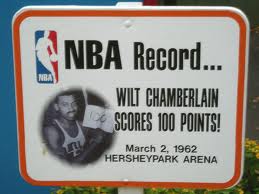Hershey, Pennsylvania was the home of an unparalleled contest between the Philadelphia Warriors and the New York Knicks. On March 2, 1962, the Warriors and Knicks arrived ready to play. Less than 5,000 fans were in attendance to watch the un-televised game. Things began heating up during the shoot around. The 7’1” Wilt Chamberlain could not miss. Once the game began, it quickly became dictated by one fact: Wilt Chamberlain did not miss very often.
The final score was 169-147. This one game illustrates the obvious: Wilt Chamberlain was a scoring machine. Wilt Chamberlain dominated the NBA’s scoring records. During the first twelve minutes of play, Wilt Chamberlain scored a total of twenty-three points and grabbed ten rebounds while his teammates scored a combined total of nineteen points. New York by contrast only scored 26 points during the first period of play. The second quarter belonged to New York. They outscored Philadelphia 42 to 37. They held Chamberlain to 18 points during the second period; this was the only period in which he scored less than 23 points. The Knicks continued to play hard and put impressive numbers on the board, racking up 38 points during the third period. Philadelphia’s play on the other end of the court produced even more impressive numbers. Wilt scored 28 points. The Warrior offensive attack garnered 18 more points.
During the last twelve minutes of the game, Wilt almost scored as many points as the entire Knickerbockers squad did. He trailed them by only ten points. The rest of the Warrior club on the hardwood added thirteen more points to round out the win.
Wilt Chamberlain played one of his most extraordinary games while wearing the Philadelphia Warriors uniform. He scored an amazing 100 points while playing against the New York Knicks that night.
[dfads params=’groups=133&limit=1&orderby=random’]
The Philadelphia Warriors were used to Wilt’s average of approximately fifty points per game. They did not realize that the performance could be special until he scored over eighty points. The remarkable part of the scoring spree is that the three-point line was not yet in effect and all of the baskets were either of the two-point variety or free throws worth only one point each. His scoring entirely rested upon the defense continuing to contain the opponents and putting the ball back into the Philadelphia Warriors’ hands. His teammates contributed to the winning cause by scoring collectively sixty-nine points. Paul Arizin and Tom Meschery both added double digits for the Warrior cause. Guy Rodgers was fouled several times. His free throw shooting ability put him into the double digits. He made nine out of twelve shots from the charity stripe and one basket from the field in four attempts from the guard position. The sixth man, York Larese, contributed eight points from the field. Due to being fouled during the act of shooting a basket, he shot one free throw and turned the possession into a three point play. At the end of the night, he was one point shy of a double digit game himself.
The Warriors’ practice paid off as their excellent marksmanship was on display from the free throw line. They capitalized on the bonus after the Knicks defense fouled them, sending them to the free throw line. The Knicks’ defense tried to contain Wilt Chamberlain’s offensive production by covering him so closely that the referees had to intervene by calling fouls and sending him to the free throw line for thirty-two attempts.
[dfads params=’groups=132&limit=1&orderby=random’]
The Knicks’ scoreboard lit up often also. Their combined efforts resulted in 147 points. Three exceptionally good Knick players had a productive shooting night as well. Richie Guerin’s performance would have been noticed as outstanding had Wilt’s shooting spree been anything other than of the highest caliber. However, Guerin’s thirty-nine total points paled in comparison to Wilt’s 100 point display of offensive talent. Cleveland Buckner, the Knicks’ boost from the bench, came on to score a close second at thirty-three points that night. Willie Naulls, a starting forward for the Knicks, powered up nine field goals and thirteen free throws for a total of thirty-one points.
Another noteworthy point for the New York Knicks is that every Knick player managed to contribute at least six points to the score. Johnny Green earned six; Darrall Imhoff threw in seven points; and Al Butler added eight. Donnie Butcher scored ten points.
Chamberlain’s rookie year (1959-60) foreshadowed the success he would have only a few years later. The 1961-62 season was a record-setting year for the player best known as the Big Dipper. Wilt Chamberlain set and shattered his own previous career highs during the season. His former achievement of 78 points in a single game was attained less than three months prior to his amazing 100 point game. By the end of the 1961-62 season, Wilt Chamberlain had exceeded 4,000 points by scoring 4,029 points in one season. Another interesting statistic showcasing Chamberlain’s work ethic was his amount of actual playing time on the floor. For the season, he played 3,882 minutes and only sat out a total of eight minutes. Because of overtime play, he averaged 48.5 minutes per game, a half minute longer than regulation play! The Warriors were involved in ten overtime periods in seven games. This one season illustrates the obvious: Wilt Chamberlain was a scoring machine with endurance.
[dfads params=’groups=131&limit=1&orderby=random’]



1 thought on “Hershey | Historic Home of the Hundred”
Comments are closed.